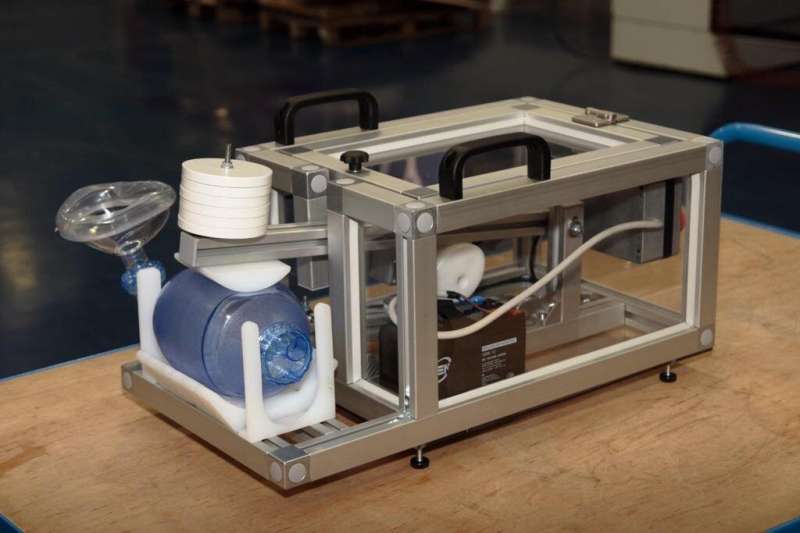DIEGO: The first low-cost and totally mechanical emergency lung ventilator

The Istituto Italiano di Tecnologia (IIT) in collaboration with the University of Ferrara (UNIFE) has created DIEGO (Device for Inspiration and Expiration, Gravity Operated) the first totally mechanical emergency lung ventilator for the artificial respiration of patients in conditions of severe respiratory failure.
The innovative engineering solution is a respiratory bag (Ambu-like) coupled with an electric motor that manoeuvres a lever; its simple design is easily replicable and quickly available for use in an emergency scenario where it is difficult to purchase new medical instruments.
The device design is an open source project and can be found on IIT dedicated website: https://www.iit.it/iit-vs-covid-19/diego-ventilator
DIEGO was developed by Luciano Fadiga, full professor of physiology at University of Ferrara, Giulio Sandini, full professor of bioengineering at the University of Genoa and research director at IIT, and Diego Torazza, design engineer at IIT.
The IIT-UNIFE DIEGO has been conceived as an emergency tool to be used temporarily in situations of serious need to provide artificial ventilation to patients. The device can vary the frequency of respiration, from five to 30 breaths per minute, responding to different patients' breathing conditions. Moreover, the system is protected by a plastic fairing that is fully sanitizable.
DIEGO uses a common respiratory bag (Ambu-like) coupled with an electric motor that activates a lever, where a weight is placed. The motor cyclically raises and lowers the mass that compresses the bag under the action of gravity. The basic idea is that the electric motor that makes DIEGO work does not compress the respiratory bag, but periodically lifts the weight from the bag, releasing it after each respiration. With this simple system, adjustments such as volume, inspiration and expiration duration and pressure are all determined mechanically without the use of electronics or complex instruments.
The device is powered by a medical grade AC-DC (12 V) converter, while a buffer battery (7Ah) guarantees system operation for about four hours in the event of a mains power loss. The device can be also powered with solar energy.
DIEGO was designed to pass rapidly from the laboratory to hospitals. In fact, following the first laboratory tests and the after obtaining permission for clinical experimentation by the Ethics Committee of the Italian Region Emilia Romagna, the DIEGO prototype was successfully used to ventilate some voluntary patients under general anaesthesia at the hospital of Ferrara, thanks to the collaboration Paolo Carcoforo, Full Professor of Surgery at University of Ferrara.
The DIEGO system is completely open source and carries the approximate cost of a mid-range mobile phone. It can therefore be made at low cost and using components that are readily available on the market, or easily manufactured. These characteristics make it particularly suitable for places where access to biomedical instruments is limited or lacking, such as health facilities facing situations of emergency or in refugee camps.
DIEGO is the first ventilator invented in Italy and submitted to the Ministry of Health for coping with the COVID-19 emergency—and given the success in the operating room, researchers have started the regulatory process to obtain the CE mark as medical device class I.
The DIEGO emergency ventilator is already in production at SCM Group, a leading multinational Italian company for the manufacture of numerical control machines, which is manufacturing a 2.0 prototype and considering methods for nonprofit distribution to interested hospitals.
According to Giorgio Zauli, Rector of the University of Ferrara: "This project represents an example of multidisciplinary interaction which, starting from the design and the laboratory phase, makes knowledge and benefits available to everyone. This is the outcome of Italy's cultural excellence."
Giorgio Metta, Scientific Director of IIT says, "The brilliant, almost Leonardesque characteristics of DIEGO's mechanics testify to the great inventive potential of our researchers. Working to solve problems and enhance technology transfer are the main objectives of IIT."
Luciano Fadiga says, "It is a beautiful story. Everyone in the team took part with great enthusiasm, and it is only thanks to this that we were able to achieve these results."
Giulio Sandini says, "We decided to work with great discretion until we were sure of the outcome. With the fundamental contribution of people like Diego Torazza we have created a prototype that has been working continuously for a month in our laboratories, showing great reliability."
Giovanni Gemmani, president at Scm Group, concluded: "The role of industry is to support and develop projects at the technological cutting-edge, not only for business purposes but also and, above all, for the common good. For this reason, we decided to become an active part, for identifying construction solutions and materials and contributing to development of the project."



















